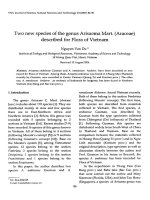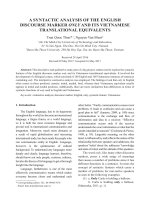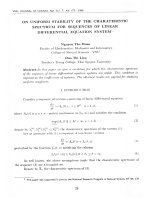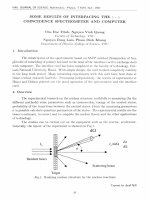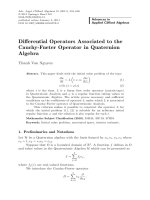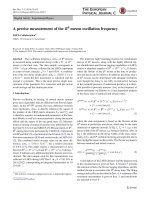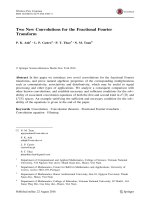DSpace at VNU: Probability measure functors preserving the regular property
Bạn đang xem bản rút gọn của tài liệu. Xem và tải ngay bản đầy đủ của tài liệu tại đây (153.87 KB, 4 trang )
V N U . JO U R N AL OF SCIENCE, M a th e m a tics - Physics. T . x x , N0 1 - 2004
P R O B A B IL IT Y M E A SU R E FUNCTORS
PR E SE R V IN G THE REG ULAR PRO PERTY
Ta K hac Cu
Department o f Mathematics, Vinh University
A bstract Let X be a topological Hausdorff space. For each k E N, by Pk ( X) we denote
the set of all probability measures on X , whose supports of no more than k points. Then
probability measure functor Pk preserve the regular property.
1. Probability m ea su r e w ith finite su p p o rts
Let X be a topological Hausdorff space. A probability measure with finite supports
on X is a function Ị1 : X —>• [0,1] satisfying the condition
supp/i = {x G X : /i(x) > 0}
(a)
is finite
fl(x) = 1 .
(b)
xGsupp/i
For each k G N, let Pk{X) denote the set of all probability measure on X . whose
supports of no more than k points. Then every /i G Pk{X) can be written in the form
Q
where ỏj: is Dirac function, th a t is
y +x
y =x
and
Q
TUi =
n (X i)
> 0 ,
TUj =
1.
G Pk( X)
1=1
T y p e se t by
19
Ta Khac Cu
20
has a neighborhood of the form 0(ụ.Q,U\)U2,—,Uq,è), where e > 0; U\ , Ư2 ,
disjoint neighborhood of
^ 2,
Uq are
X® respectively ( note that Ui can be taken from a fixed
basis of topology of X) .
<7+1
O(ụ.0, ư i , ư 2 , . . . , U q , e ) ' = {ụ,
Pk( X) : n
=
y^/X t,supp Hi G Ui, I
i = l , 2 , . . . , q + l ; U q+1= X \ [ j U it
It is easy to see that the family O(/i0, U\, Ư2 ,
- \\m\w
<
e
m°q+l = 0 }.
Uq, e) forms a basis of a topology of Pk{X).
This topology is called Fedorchuk topology.
2. T h e R e s u lts
In this section we shall prove th a t the functor Pk preserve the regular property.
T h e o r e m 2.1. I f X metrizable, then so is Pk(X), for any k E N.
The proof of theorem 2.1 is based on the following fact due to Frink [Fr].
T h e o r e m 2.2.
[Fr]. A T\-space X is metrizable i f and only if the following condition
holds:
(Fr) For each
X
e X there exists a neighborhood basis
{Un{x)}%Lị
satisfying the
following condition: if Un(x) is given there exists an m = m ( x , n ) such that Urn(y) n
0 implies u m(y) c Un{x).
u m{x)
Proof. Obviously Pk{X) is a T \ -space. Thus, by Theorem 2.2 it suffices to verify the
condition (Fr).
At = Ỵ^rriiỗXi e Pk{X),
q < k,
we define a neighborhood basis {On (/i ) } ^ =1 satisfying the condition (Fr).
For each 2 = 1, ...,g we take {Un ( x i ) } n such that
dia.mi/n(xi)
<
- m in {2 n , dist([/n (£i), u n ( xj ) ) \ i
{Un (xi)}™==l satisfies the condition (Fr).
We put
On {iM>,Uĩì U ĩ ì ...,UĨ,€n(ụ)),
Ỷ j}-
(1)
(2)
Probability measure functors preserving the regular property
where UỊ1 = u n (xi),i — 1 ,
21
and
en (/i)) < min{2 ~n , m l)i = 1,2,..., ợ}.
Let us show that {On (/x)}^L1 satisfies (Fr).
Given On(fi). Since en (7 ) < 2“ n for every 7 G Pk{X) there exists an m £ N such
that
f m ( t ) < - 7 min{en (/i),m i ,i = 1
,
(
3
)
for every 7 G Pk(X). We shall prove that m(/x, n) = max{m, m(xi, n), i =
satisfies
the desired property of (Fr).
Assume that 0 m { 7 ) = 0 ni(7, Vjm, F2m,
e
m(7 )) with 0 m(7) n Om (ụ,) 7Ể 0.
,2 = 1,
Take 9 G 0 m (7 ) n 0 m (/i) and w rite ỡi =
q and let
0<7+1 — $ l x \ U L i uỵn’ ^ ?; = s u P P ^ i i z =
Since
||0 ?;|| > m i -
€m (/z ) > rrii -
1
3
-V d i =
2 , < 7 + 1.
> €m ( j ) , i = 1 , 2 , . . , ạ,
we infer that for every 2 < Ợ there exists at least j £ {1,
Gl = ỊJ{V,- : Vj n A, ^ 0},* = 1 ,
such that i4i n
Q
A j 7^ 0. Let
ợ; Gq +1 = (J{V,- : ^ C I \ [ J A,}.
2=1
Since A-i c [7™ from ( 2 ) it follows that
Gj c UỴ1 for every i = 1 , ...,<7.
We shall show th a t O m(7 ) c On (/i). For every
i
= 1,2 ,
q
+ 1;
Wi j
=
for Vj c G*;
9tJ
(4)
G Om (7 ) we denote Wi
= 0i|v- for Vj c GV Since
w, 6
= iu|gì
for
G Om(7 ) it
follows
lllwijll -
P u ll
< 2em (7).
Note that k > r > Card{j : Vj c Gi}. From (3) we obtain
I M ~ 11^2 II — ^
II k y II — I I M
< 2 fcem(7 ) < —€n(/i)
VjCGi
for every 2 — 1 , Ợ + 1. Hence
1
Will -
TOi| <
■™i|| -
IN I
+ || 0t -
m ill <
2 6 n (^ ) + e™ (^ ) < en (/i)
for every 2 = 1, ...,ợ and by (5) we have
| | w g+ i | | < ||0<7+l|| +
— e™( ^ ) +
Consequencetly from (4) we infer that
w e On(/i).
This completes the proof of theorem 2.1.
2Cn{ụ) <
en ( / Ạ
(5.)
Ta Khac Cu
22
Theorem 2.3. I f topological space X is T\ and regular, and the topology has a Ơ—locally
finite base, then so is Pk{X) for any k G N.
Proof. Since X is T\ and regular and topology has Ơ—lacally finite base, then X metrizable.
Thus by theorem 2.1 it follows th a t Pk( X) is m etrizable and satisfies condition Ti-space,
and regular, and topology has a Ờ—locally finite base.
This completes the proof of theorem 2.3.
References
1. R.Engelking, ’’General Topology” , Warzawa. (1997).
2. v .v . Fedorchuk, ”Probability measure and absolute neighborhood retracts.” , So
viet. Math. Dokl 22(1986).
3. Ta Khac Cu, ”Probability measures with finite supports on-topological spaces”, J.
Math and Physics. VNU, T.XIX 4(2003).
